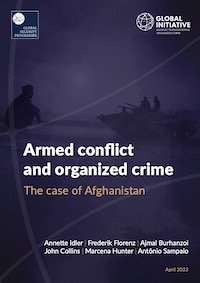By Iffat Idris
Conflict in eastern Ukraine has been underway since 2014: the February 2014 ouster of pro-Russia President Yanukovych was followed in March by Russian annexation of Crimea, and its support for insurgency in the Donetz Basin (Donbas) – the latter is ongoing. This paper is a rapid literature review of the links between corruption, crime and conflict in eastern Ukraine. While Russia’s 2014 annexation of Crimea was rooted both in Moscow’s historic claims to the peninsula, as well as moves by Kiev to move closer to the European Union, the ongoing insurgency in the Donetz Basin (Donbas) stems from structural factors such as industrial decline. Russian support for the Donbas insurgents, alongside its failure to recognise the republics that they announced (Donetsk People’s Republic and Luhansk People’s Republic), suggests that Moscow’s real goal is to put pressure on the Ukrainian government and prevent its integration into Western structures. The paper assesses the impact of the conflict on the economy of Crimea and Donbas. Russia has tried to demonstrate the benefits to Crimea of annexation by pumping vast resources into the region, but this resource injection has been unable to overcome the effects of wide-ranging Western sanctions. Donbas’ economy has been even more badly affected by ongoing conflict, with thousands displaced and an economic blockade imposed by Kiev greatly limiting trade. Here too, Moscow has had to step in with subsidies and humanitarian assistance. The paper also looks at the involvement of organised criminal groups (OCGs) in the conflict, and the impact of the conflict on organised crime in the region. With regard to the former it finds that OCGs played a big role in Russia’s annexation of Crimea, fighting alongside Russian forces (without their insignia) and other volunteers. This highlights the complementary and symbiotic nature of the connection between criminal groups and the Russian state. OCGs in the Donbas region had strong links with the Yanukovych government in Ukraine, ousted in 2014 – hence it is no surprise that these groups were heavily involved in the Donbas insurgency. With regard to how organised crime has been affected by conflict, the paper finds that corruption was a massive problem in Ukraine long before the conflict in the east. Moreover, it involved all levels of the government system and was strongly linked to organised crime. OCGs were especially prevalent in Crimea, while Donbas was even more notorious for criminality. Post-Crimea’s annexation, links between OCGs in Crimea and in Russia became even stronger. Ironically, due to the vast influx of Russian development funds, Crimea represented an opportunity for embezzlement and corruption for Russian and Crimean OCGs. Closer ties were even forged between Russian OCGs and those in Ukraine. Since the conflict in Donbas began – and given the economic blockade, and falling Russian funding support - the region has become heavily dependent on organised crime. The paper also finds that oligarchs, with close ties to organised crime, have benefited hugely from Crimea becoming part of Russia, e.g. seizing property belonging to pro Ukraine business elites. Ties with political elites are equally strong: gangs gain protection from political patronage, in turn giving kickbacks to politicians. One final aspect explored in the paper is transnational crime. It finds that this has risen since the annexation of Crimea and conflict in Donbas, including a rise in smuggling of illicit goods into Europe, and a rise in organised crime in Ukraine. Sevastopol could potentially take over as a smuggling hub from Odesa, while Crimea and Ukraine could become a global money laundering centre. Criminality in Russia has also increased, seen in rises in drug and arms trafficking and criminal cases. The drop in cross-border cooperation to combat crime has contributed to greater criminality. The paper concludes that corruption, crime and conflict are heavily intermeshed in eastern Ukraine, with each reinforcing the other in what appears to be a downward spiral of escalation.
SOC ACE Evidence Review Paper No. 2. Birmingham, UK: University of Birmingham. 2022. 26p/





















